|
Page < 1 2 3 4 5 6 7 8 9 10 11 12 13 14 15 >
Ramayana
- A Timeless Tale
The
Greatest
influence on almost all of the arts of South east Asian region has been from
India. The "Ramayana" tells of good defeating evil. It
offers inspiration and spiritual fulfillment
.
This
sacred Epic has been deeply
etched in the collective psyche of all the countries of Southeast
Asia.
In second place, but far behind, has been the cultural
forms from China. Of all the Indian inspirations, the most
important ones have been related to the Ramayana
– an epic story of Prince Rama, his loving wife Sita, and
their adventures following her abduction and rescue from a
demon-king Ravana. Each episode of the story provides
entertainment, but also instruction on the virtues: courage,
honesty, morality, loyalty, duty and trustworthiness. The great
theme is that of the triumph of good over evil. Another Indian
masterpiece is the Mahabharata, which tells of heroic struggles
among the ruling families of India.
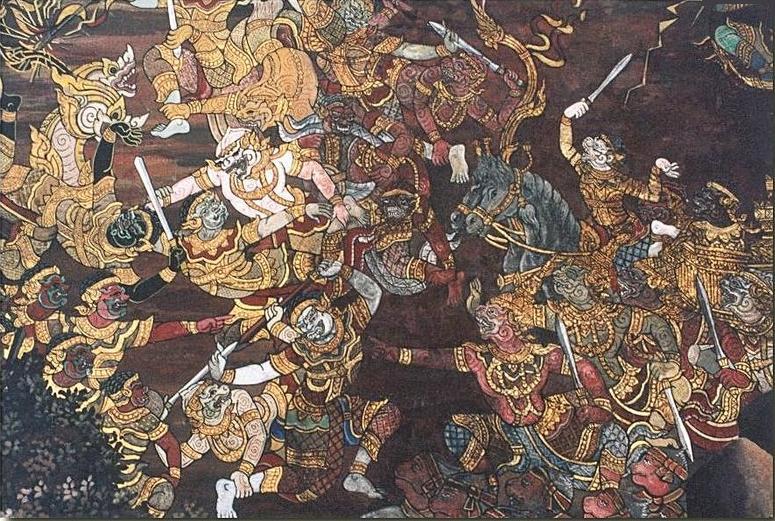
The
Thai Ramakien: Literally means "Ram akhyan"..
In
Southeast Asia, the story of Rama has become a traditional part
of culture in Buddhist Burma, Thailand and Cambodia. In Malaysia
and Indonesia.
Watch
Video on Save
Ramsetu. Watch
Scientific
verification of Vedic knowledgeWatch
video - Brahmins
in
India
have become a minority
***
In India, where
plays have been presented in almost every community for
centuries, everyone knows the epics almost by heart. In
Southeast Asia, the story of Rama has become a traditional part
of culture in Buddhist Burma, Thailand and Cambodia. In Malaysia
and Indonesia, this story had become popular long before the
conversion of the people to Islam. It is kept alive, in slightly
modified versions, in all countries of the region.
(source: Southeast
Asia: Earliest Indianized Kingdoms – By M Ladd Thomas
p.
45 - 79 and 80 -
84).
Ramayana is well known to the Thai people as
Ramakien, the
name being derived from the Sanskrit term Ramakirti. According to their
knowledge, it was written by Sri Valmiki more than 2000 years ago.
The Ramayana or Ramakien has been appreciated by the Thai
people for ages. In Ayudhya period it was regarded as the sacred
story and is because of the story of Ramayan that the first King
of Ayudhya was named Rama and its capital, Ayudhya. The Ramayana
written by Ramayana scholars in Thailand is divided into 7 Kandhas
or sections.
The Ramayana story as found in Thailand, according to the
great scholar of Thai literature, Phraya
Anumanrajthon, did not
come directly from India, but it came from Indonesia about 900
years ago. At that time on a lot of ruins are depicted the scenes
from the Ramayana story. One of the most outstanding examples is
found in the stone shrine “Prasat Hin Pimai” in the Pimai
district, Nakhon Rathaseema Province, north-east of Bangkok. In
King Ramkhamhang’s inscriptions was mentioned the cave of Rama
and Sita.
At a later time, when Taksin became King of Dhonburi, he
wrote the Ramayana in Thai verses. They are of 2012 verses in four
volumes:
- Phra
Mangkuta practicing the art of bow.
- Hanuman
courting Nang Vanarin.
- King
Malivaraj ajdudiating the case.
- Thosakan
(Dasakantha) setting up the ceremony of making sand acid to be
his weapon.
(source: The
Ramayana Tradition in Asia - By V Raghavan. p. 245 -
255).
Ayuthaya has a great
significance for Indians. The name Ayuthaya was derived from the
original Sanskrit name Ayodhya.
This city (Ayodhya) was the
capital of the ancient Hindu Kingdom (around 1500 BC) of Rama, a
great king and hero of the Hindu epic Ramayana. The ancient city
still exists and is situated on the banks of the Sarayu River
in
the northern part of India.
Although Thailand is
today predominantly Buddhist, there are traces of Hindu
influence, visible mostly in the court ceremonials. Until
recently, the court Rajguru Brahmins cast horoscopes, consulted omens,
and performed worship of both Hindu and Buddhist deities.
Ceremonies of coronation, tonsure, cremation, and lesser rites
connected with agriculture were developed by the Brahmins. The
Siamese call their coronation by its ancient Sanskrit
designation, the Rajabhiseka. The
entire complex of coronation ceremonies, such as homa (sacrifice
of Fire), purificatory rites, ablutions, anointment, are closely
modelled on Hindu rituals, and are presided over by the Brah
Maha Raja Guru.
The tonsure ceremony in Siam is a
rite of initiation of youths, corresponding to the Hindu
Cudakarma Mangala, which is very important Hindu
Samskara. Cremation, an old Vedic rite, is the only means of disposal of
the remains of deceased royalty in Siam.
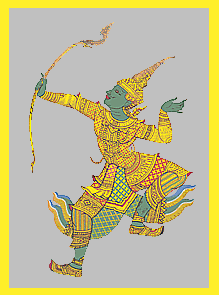
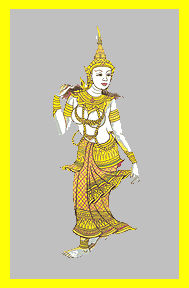
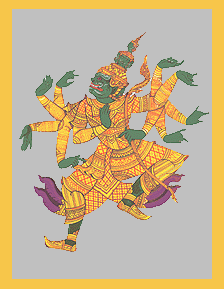
Even
today, the Kings of Thailand bear the royal title is Rama, a
Hindu avatar, and the story of Ramayana is depicted on the
palace and temple walls of Bangkok.
Watch
Video on Save
Ramsetu
***
Even
today, the Kings of Thailand bear the
Royal title is Rama, a
Hindu avatar, and the story of Ramayana
is depicted on the Royal Palace
and temple walls of Bangkok.
Hindu
festivals such as Dashahara, commemorating the victory of Rama
over the demon king Ravana, are still observed in Thailand.
The
Thais, like the Hindus, still believe in Vishnu or Naryana (Phra
Narain), and Mahadeva or Siva, and dislike the asuras (asuns) as
the enemies of the devas.
 Famous Indian works,
such as the Ramayana and Mahabharata, and the Shakuntala have
formed the basis of some of the outstanding Siamese literature. Famous Indian works,
such as the Ramayana and Mahabharata, and the Shakuntala have
formed the basis of some of the outstanding Siamese literature.
The Ramayana, known in Siam as the Ramakien
"Ram - Akhyan" where
Akhya is a Sanskrit word
meaning "rendition of the story of".
Phendin-Klang Rama II
(1809-24), was an outstanding poet, producing Thai translations
of the Hindu Ramayana.
It is
regarded as Siamese classic. Knowledge of this work is as
essential for a cultured Siamese as Homer used to be for an
European. The epic and Puranic
literature of India constituted the principal source
of inspiration not only for Siam but for the whole of Southeast
Asia. It provided the themes for classical theatre, shadow
theatre, and marionette shows.
Indian influence is
clearly seen on Siamese dance, drama, and music. Many of the
themes of Siam's various dance-dramas (lakhon-ram) are drawn
from Indian stories: for example, the
story of Savitri and Satyavan. Many Thai musical
instruments closely resemble those of India. The Siamese legal
system is directly descended from the Manusmriti. The Hindu Dharmasastras,
provided the framework for Siamese justice.
Thai language too bears close affinity with Indian An
indication of the close linguistic affiliation between India and
Thailand can be found in common Thai words like Ratha Mantri,
Vidhya, Samuthra, Prachinpuri, Karuna, Prannee etc. which are almost
identical to their Indian counterparts. Thai language basically
consists of monosyllabic words that are individually complete in
meaning. His Majesty King Ramkhamhaeng the Great created the
Thai alphabet in 1283. He modeled it on the ancient Indian
alphabets of Sanskrit and Pai through the medium it on the
ancient Indian alphabets of Sanskrit and Pali through the medium
of the old Khmer characters.
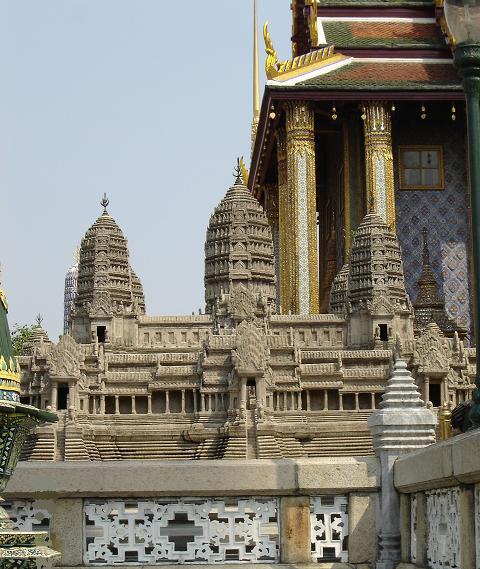
Angkorwat -
miniature in Bangkok Palace, Thailand.
(source:
webmaster's own collection of photos taken during a recent visit).
***
The tales of the Ramakien are
similar to those of the Ramayana, though transferred to the
topography and culture of Ayutthaya, where the avatar
of Phra Narai (the Thai incarnation of
Vishnu)
is reborn as Phra Ram.
The
Thai kingdom of Ayutthaya, named after Rama’s capital of
Ayodhya, was itself sacked and destroyed by invading armies from
Myanmar in the 18th century, resulting in the loss of
literary works. When a new capital was established at Bangkok
shortly after, one of the first tasks of King Rama I, who took
on the name of the hero of the epic, was to have the lost
Ramakian composed again. The episodes were rearranged, however,
in a more linear time fashion. In addition, Tamil tradition
probably played an important role in the royal literary effort,
for the Thai epic has many features in common with southern
Indian ideas, such as strong females (which also is an
indigenous Thai trait), soul transfer, and characters magically
transforming themselves into other beings. Many of the ogres
have special powers or weapons, and they are defeated in unique
ways with help from Vibhisana. Hanuman becomes as lover to many
women and has several wives, thus completely going against the
entire Indian tradition in which he remains celibate and
unmarried. The brothers of Rama and even his sons battle against
the surviving ogres and destroy them, thus repeating several
motifs and greatly increasing the length of the epic.
(source:
A Timeless Tale).
Thailand,
Nepal honor legendary Indian
King
- Janak of Ancient Mithila
A
legendary Indian king is being feted by Nepal and Thailand.
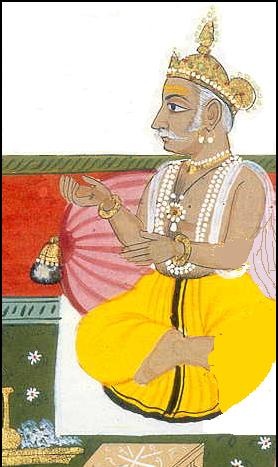 The
two countries are coming together to pay a tribute to King Janak
of ancient Mithila on the occasion of the 76th birthday
of King Bhumibol Adulyadej of Thailand as
well as the Thai National Day. The Nepalese translation of a
magnum opus by the Thai king himself, "The Mahajanaka: The
Story of King Janak of Ancient Mithila", will be distributed
free in Nepal to symbolise the ties between Nepal and Thailand.
The genesis of the royal book goes back to 1977 when King Bhumibol
was listening to a sermon about King Janak from "Tripitaka",
the sacred texts of Theravada Buddhism. The
two countries are coming together to pay a tribute to King Janak
of ancient Mithila on the occasion of the 76th birthday
of King Bhumibol Adulyadej of Thailand as
well as the Thai National Day. The Nepalese translation of a
magnum opus by the Thai king himself, "The Mahajanaka: The
Story of King Janak of Ancient Mithila", will be distributed
free in Nepal to symbolise the ties between Nepal and Thailand.
The genesis of the royal book goes back to 1977 when King Bhumibol
was listening to a sermon about King Janak from "Tripitaka",
the sacred texts of Theravada Buddhism.
The Thai royal was especially impressed by a tale about King
Janak's visit to the royal park in Mithila, believed to have been
located in modern day Bihar in India. At the entrance of the park,
the story went, stood a fruit-bearing mango tree and a barren one.
While coming out of the park, the king saw that the mango tree
with delicious fruits had been uprooted by his entourage. The
parable taught the lesson that good things are endangered by
greed.
King Janak is said to have been revered
for his just ways as well as being the father of Sita, the consort
of god Ram.
"The
underlying themes of self-reliance, moderation and compassion in
the story of King Janak struck a chord with the king's Thai
subjects who were increasingly disenchanted with materialism in an
era of instant gratification," wrote Sudhindra
Sharma, a visiting scholar at The Institute of Asian Studies at
Chulalongkorn University in Bangkok.
The Thai king's daughter, Princess
Maha Chakkri Sirindhorn, a student of
linguistics and Sanskrit, is said to be researching King Janak and
Mithila.
(source: Thailand,
Nepal honor legendary Indian
King
-
Newindpress.com
- December 6 2003). Watch
Scientific
verification of Vedic knowledge
Top
of Page
Page < 1 2 3 4 5 6 7 8 9 10 11 12 13 14 15 >
|